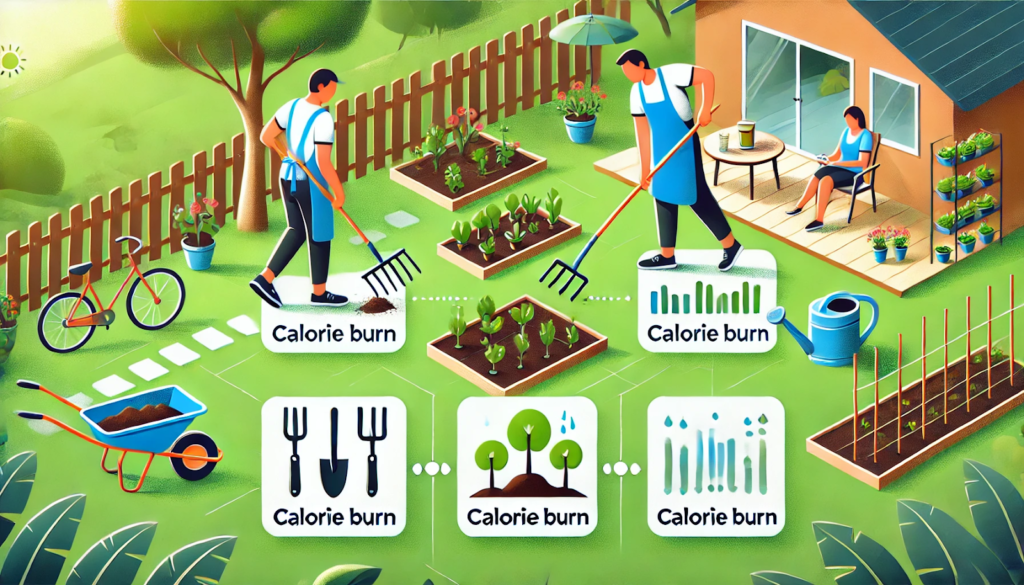Think gardening is just a relaxing hobby? Think again. Gardening can be a full-body workout that burns calories, builds strength, and boosts heart health—without ever stepping foot in a gym.
In this guide, we break down how gardening counts as real exercise and how many calories you can burn doing everyday garden tasks.
1. Is Gardening Really Considered Exercise?
Yes. According to the CDC, gardening qualifies as moderate-intensity aerobic activity. It combines movement, resistance, and balance in a way that improves your overall fitness.
Health Benefits:
- Increases cardiovascular endurance
- Improves muscle tone and flexibility
- Supports mental health and mood
- Enhances core stability and coordination
And it’s more fun (and productive) than a treadmill.
2. Calorie Burn by Gardening Activity
Calories burned vary by intensity, body weight, and duration. Below are estimates based on a 150-pound (68 kg) adult over 30 minutes:
| Activity | Calories Burned |
| Digging or Shoveling | 200–250 |
| Raking Leaves | 120–170 |
| Planting and Weeding | 130–180 |
| Pushing a Wheelbarrow | 160–210 |
| Mowing the Lawn | 150–230 |
| Watering Plants | 60–100 |
| Carrying Bags of Soil | 180–240 |
| Harvesting Vegetables | 90–120 |
Heavier individuals may burn even more.
3. Muscles Worked While Gardening
Gardening is surprisingly full-body.
Muscles Engaged:
- Core – bending, lifting, reaching
- Legs and Glutes – squatting, walking, pushing
- Arms and Shoulders – digging, pruning, carrying
- Back – pulling weeds, raking, and shoveling
Proper form helps reduce strain and build strength effectively.
4. How Gardening Improves Physical Fitness
Regular gardening supports:
- Heart health from consistent movement
- Better balance and coordination
- Improved flexibility through natural motion
- Increased stamina when working for long periods
Plus, time spent outdoors boosts vitamin D, which is vital for bone health.
5. Tips to Maximize Gardening as Exercise
A. Treat It Like a Workout
- Warm up before lifting heavy tools
- Switch sides and vary tasks to avoid overuse
- Take breaks and hydrate regularly
B. Use Your Body Intentionally
- Squat instead of bending at the waist
- Use your core when lifting or digging
- Walk or carry instead of wheeling every time
C. Track Progress
- Use a fitness tracker to log gardening sessions
- Aim for 150 minutes per week of moderate activity
- Reward yourself with a healthy garden snack
6. Mental Health Boost Counts Too
Physical benefits aside, gardening also reduces:
- Cortisol levels (stress hormone)
- Symptoms of anxiety and depression
- Mental fatigue through mindful, repetitive tasks
It’s a rare workout that strengthens both mind and body.
7. Combine Gardening with Healthy Habits
- Stretch before and after gardening
- Use ergonomic tools to prevent injury
- Mix gardening with walking, yoga, or strength training
- Eat your homegrown vegetables for nutrition
Your garden can be the centerpiece of a holistic, healthy lifestyle.
Conclusion: Grow Strong, Stay Active
Gardening is more than just digging in the dirt—it’s an effective form of exercise that improves strength, endurance, flexibility, and mental wellness. Whether you’re planting, weeding, or harvesting, you’re getting a workout with purpose.
So next time you step into your garden, know that every move is making you healthier—one plant at a time.






